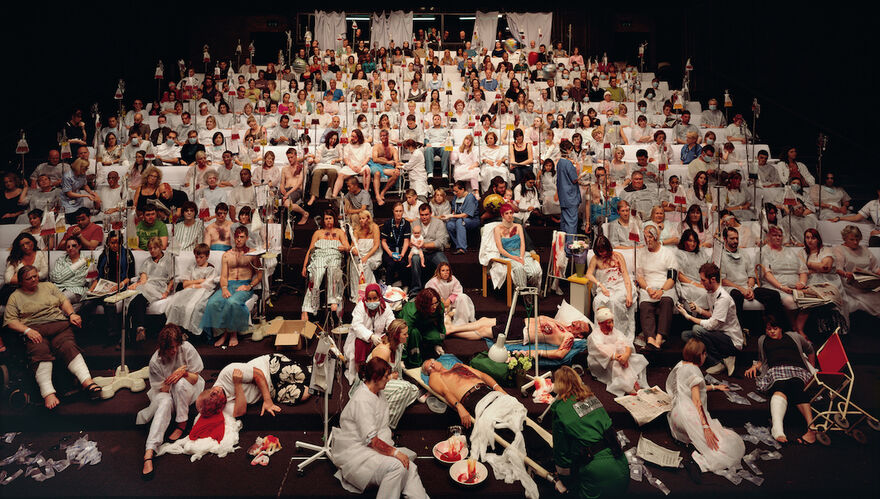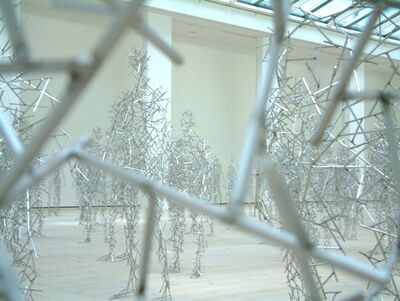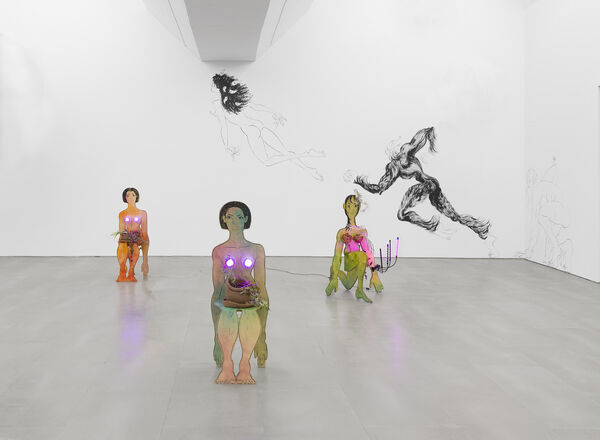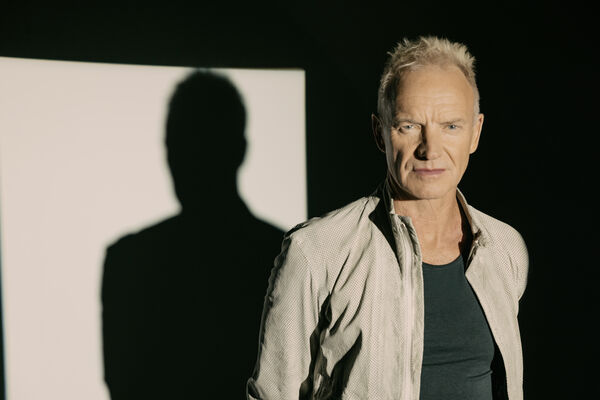Taking Part
25 Jul 2022
Some of the artworks Baltic has had a hand in over the past 20 years have involved volunteers.

David Whetstone picks out some of the most memorable and dramatic.
Anyone else remember the sensation of quick-drying plaster hardening to a carapace around your head as the reassuring voices around you became muffled?
Or the trepidation, or possibly excitement, as the order came (from a man up a stepladder) to strip naked in the dawn light beside the Tyne?
Or even the sense of ‘What the heck?’ as make-up artists transformed you into an accident victim like an ‘extra’ in an episode of Casualty?
Perhaps you were one of those who responded to the call for “serious” John Lennon fans to take part in a video tribute?
Or maybe you were one of those who helped to evoke infinity by reading out long numbers as curious members of the public looked on?
If the answer to any of these is yes, then you have been an integral part of one of the volunteer-reliant projects that have helped to make Baltic’s first 20 years so richly memorable.

DOMAIN FIELD came early in the life of BALTIC with a call-out in January 2003.
“Antony Gormley and BALTIC are offering 240 regional volunteers the chance to participate in an unusual and exciting new project,” it went.
I loved the ‘offering’!
Local volunteers between five and 95 were invited to be cast in plaster, for which they would need to be naked, by specially trained staff.
Loved that ‘invited’!
It was explained that the plaster casts would be used as moulds in which to construct sculptural forms made of stainless steel bars.
The first impression of the work, to be called Domain Field, would be of a “mist cloud” on Level 4.
In the end, there were 1,000 volunteers and 286 of them underwent the treatment.
For both volunteers and staff it proved demanding and unforgettable. So this was what BALTIC founding director Sune Nordgren meant by an ‘art factory’?
That was certainly what it looked like from the viewing gallery with plaster casts lined up against the walls and staff in powdered overalls.
Reflecting on the experience, the oldest volunteer, 84-year-old Christina Gould, remarked: “I felt so uplifted. It was wonderful.”
Someone who worked as plasterer and welder told me recently that she remembers how her hands became sore and chapped during the mammoth operation.
Domain Field was a tremendous success, something for volunteers to say proudly that they had been involved in and a moving spectacle for visitors as they studied first the ‘mist cloud’ and then the individuals within.

SPENCER TUNICK also sought volunteers for his photo shoot on Gateshead and Newcastle quaysides in summer 2005 in a commission by Baltic and BBC Three, delivered in partnership with Newcastle Gateshead Initiative.
Once again nakedness was the requirement (people were growing accustomed to this) but this time there would be no private booth or plaster cast to hide behind.
In the very early morning of July 17, 1,700 people of all shapes and sizes stripped off and followed the instructions of Tunick and his team.
They (well, we, for again I was among them) crossed the Gateshead Millennium Bridge and lay down in a line along Newcastle Quayside, hoping the wheeling kittiwakes would spare us an unwanted gift.
Tunick took photos from the Tyne Bridge and then more at Side, just off Newcastle Quayside, below Sage Gateshead and finally on what was a carpark but is soon to be the new arena and conference centre.
Embarrassment dissipated quite quickly, hilarity was always to the fore and one or two participants, there by virtue of their pregnant mums, remained blissfully unaware of their involvement.
The resulting Tunick photographs, along with a popular video, were displayed on Baltic’s Level 2 from January 2006.
A jovial couple from the Natural Theatre Company, sporting ‘nude’ body suits, paraded up and down the quaysides to publicise the show.
It was during a residency at BALTIC in 2006 that Candice Breitz set in train the process that would lead to WORKING CLASS HERO (A PORTRAIT OF JOHN LENNON).
The call went out to John Lennon fans who wished to pay tribute to their hero in an unusual way in a Newcastle recording studio.
Casual music lovers who didn’t mind a bit of the former Beatle’s output were not the target.
“You have been a Lennon fan for 30 years or more. You know the lyrics of Plastic Ono Band. You love to sing. You are not shy in front of a camera. You want to pay tribute to John Lennon. Only serious fans need apply.”
These were the strict requirements. And, naturally, there were plenty who fit the bill.
Each fan was tasked with performing Lennon’s first solo album, released in 1970, from start to finish.
The resulting video installation, lasting 39 minutes and 55 seconds (the same as the album) was shown on 25 plasma screens positioned from the top to the bottom of Baltic’s seven-storey public staircase.
Each screen showed one fan’s performance of this landmark album exploring the traumas of Lennon’s childhood.
For Baltic visitors it added an extra dimension to the experience of taking the stairs.
For some, it might be added, the appeal of the lifts was considerably enhanced for the duration of the work, which was noisily on display until the end of January 2007.

TEMPORARY WARD was the name given by Chinese artist Wang Qingsong in a Baltic presentation in 2008 as part of EAST ’08.
This was an element of the Culture 10 programme, the decade’s worth of cultural activity established after Newcastle and Gateshead were narrowly pipped to the European Capital of Culture title
Wang Qingsong had been approached the previous year by Northern Stage to see if he would like to respond to their redeveloped theatre and the regional cultural renaissance.
The answer from an otherwise enigmatic artist was an emphatic yes.
As a result, 300 volunteers – me and my daughter among them – spent an unusual September Saturday at Northern Stage.
All of us arrived looking the picture of health and became increasingly the worse for wear as the make-up artists transformed us into an A&E department’s direst nightmare.
Carefully arranged in Northern Stage’s big auditorium, many of us with saline drips, some on stretchers and with more bandages than a convention of mummies (the Egyptian kind), the artist eventually pressed his camera shutter and that was that.
The aim, apparently, had been to explore the notions of pain and healing and of theatre as a cathartic experience.
Some time later, we all received a commemorative photograph. I keep mine with the one I got from Spencer Tunick of naked people on Newcastle Quayside.
ONE MILLION YEARS required nobody to get naked or sing or have make-up applied. Its demands on those taking part were challenging but subtle.
On Kawara, a celebrated Japanese artist based in New York since the 1960s, was fascinated by the relentless passage of time and gave substance to it in this famous work.
It started in 1969 and comprises two sections.
Past consists of a typed record of every year from 998,031 BC to 1969 AD. Future covers the years 1996 AD to 1,001,995 AD.
Readings of the work, beside which the old telephone directories are like the works of Shakespeare, had taken place around the world before One Million Years rocked up at Baltic during March and April 2012 as part of the AV Festival whose theme that year was As Slow As Possible.
All volunteers had to do was read out the dates. Two people at a time, always a man and a woman, would alternately read out the dates with no gaps during gallery opening hours.
It didn’t seem much to ask. But seated at a desk within a windowed booth in an otherwise empty gallery, the pressures mounted as the readers’ allotted hour progressed.
Long numbers have always caused my mind to boggle. You were desperate to read clearly and not to stumble. God forbid that you should giggle or sneeze.
At a festival in Germany they had sustained the readings for 100 days. The couple of months at Baltic was probably quite enough for all concerned.
It lives in the memory as something odd but moving.
Sadly but inevitably, time did eventually run out for On Kawara who died in 2014, aged 81.




